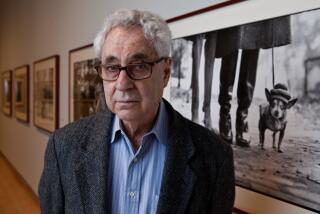Pictorialist William Mortensen, reviled by Ansel Adams, gets new respect
- Share via
Ansel Adams called him “the antichrist.” William Mortensen wasn’t merely a rival in the still-young art of photography nearly a century ago, but his pictures were windblown and cinematic, depicting scenes of sexual tension, violence and the occult.
Even worse, Mortensen was a West Coast leader of the Pictorialist school, manipulating his images at will with brush and razor blade, adding texture to portraits and epic historical tableaux. The work was the polar opposite of the crisp and modern “straight photography” championed by Group f.64, headed by Adams and Edward Weston.
“He was trained as a painter, so his approach to photography was like a painter in that he did whatever you needed in order to make the image happen,” says Larry Lytle, co-editor of “American Grotesque: The Life and Art of William Mortensen.” “Ansel Adams tried to keep Mortensen out of the photography textbooks ... and to belittle him.”
Photography critic A.D. Coleman, a longtime champion of Mortensen who contributes a chapter, wrote: “Adams’s vendetta pursued Mortensen even beyond the grave, and well into the terrain of outright censorship and blackmail.”
That effort was successful, despite Mortensen’s early career as a photographer in Hollywood, as owner of a busy photography school in Laguna Beach, and as the author of a series of popular technical manuals and columns in Camera Craft magazine and the Los Angeles Times. He was left unmentioned in an influential book on the history of photography written by Adams’ friend Beaumont Newhall, who dismissed Mortensen’s work as “perverse.”
By the time of his death in 1965, Mortensen’s once-prominent name had faded to obscurity. His work and archives were scattered posthumously among his students and admirers, or lost and destroyed.
In 1987, Mortensen was included in “Masters of Starlight: Photographers in Hollywood” at the Los Angeles County Museum of Art, but larger individual recognition eluded him.
The book is meant to help reverse that. It’s the culmination of a three-decade investigation into the life and career of Mortensen by Lytle, who first discovered the photographer’s work at small 1980 gallery show in Hollywood.
“Everybody has said, ‘Why do you want to deal with this guy’s work? It’s kitschy, nobody likes it, museums don’t collect it,’” says Lytle, a photographer and lecturer at Cal State Channel Islands. “But I really just liked his work.”
On Thursday, Mortensen will be celebrated at the Cinefamily theater with a book signing and screening of “West of Zanzibar,” his 1928 collaboration with “Freaks” director Tod Browning. A collection of Mortensen photos will be on display there through March 19.
“We’re trying to rediscover him, refurbish his reputation,” says Feral House publisher Adam Parfrey, who became aware of Mortensen through Church of Satan founder Anton LaVey, whose “Satanic Bible” was dedicated in part to the photographer.
On the cover of “American Grotesque” is the 1935 image of a hulking gorilla standing over an unconscious woman, her clothes torn, a trickle of blood on her cheek, an echo from “King Kong.” The mostly black-and-white pictures inside reflect a range of interests, including elegant portraits of Hollywood star Carole Lombard, Los Angeles spiritualist Manly P. Hall and the photographer’s brooding “Witchcraft and Demonology” series.
Several pages have nudes and scenes of violent historical horrors in disturbing detail. The handmade alterations that were so objectionable to Adams seem now to predict manipulations common through Photoshop and other digital tools.
The darker inclinations of Mortensen’s grotesques have also emerged in later pictures by Joel-Peter Witkin and Matt Mahurin, among others. The largest Mortensen collection of surviving materials is at the Center for Creative Photography in Tucson.
“The f.64 people really viewed Mortensen as passé — that they were the avant-garde of what photography should be, and Mortensen’s time was gone,” says Michael Moynihan, co-editor of the book. “In some ways, they were right historically. On the other hand, now you can see that Mortensen was this visionary. Things have turned again, and he’s as relevant now as when he was working.”
------------
‘The Devil’s Photographer: William Mortensen and Hollywood’
What: Screening of “West of Zanzibar,” book signing by Larry Lytle and exhibition of William Mortensen photography
When: 7:30 p.m. Thursday
Where: The Cinefamily, 611 N Fairfax Ave., Los Angeles
Admission: $12
Info: (323) 655-2510, www.cinefamily.org
More to Read
The biggest entertainment stories
Get our big stories about Hollywood, film, television, music, arts, culture and more right in your inbox as soon as they publish.
You may occasionally receive promotional content from the Los Angeles Times.











